Simplified Synthesis of the Amine-Functionalized Magnesium Ferrite Magnetic Nanoparticles and Their Application in DNA Purification Method
Abstract
:1. Introduction
2. Results and Discussion
2.1. Surface Area Measurements
2.2. Particle Size Distribution
2.3. XRD Characterization of Amine-Functionalized Magnesium Ferrite Nanoparticles
2.4. FTIR Measurements
2.5. Magnetization Measurements
2.6. pDNA Isolation with Amine-Functionalized Magnesium Ferrite Nanoparticles
2.7. Restriction Digestion of the Extracted pDNA
3. Materials and Methods
3.1. Materials
3.2. Synthesis of the Amine-Functionalized MgFe2O4-H&R by Coprecipitation with 12-h Refluxing
3.3. Synthesis of the Amine-Functionalized MgFe2O4-MW by Microwave Irradiation-Assisted Coprecipitation
3.4. Characterization Techniques
3.5. pDNA Isolation with Magnesium Ferrite Magnetic Nanoparticles
3.6. Gel Electrophoresis
3.7. Quantification of pDNA and Restriction Endonuclease Reactions
4. Conclusions
Author Contributions
Funding
Institutional Review Board Statement
Informed Consent Statement
Data Availability Statement
Conflicts of Interest
References
- Hajdu, V.; Sikora, E.; Kristály, F.; Muránszky, G.; Fiser, B.; Viskolcz, B.; Nagy, M.; Vanyorek, L. Palladium Decorated, Amine Functionalized Ni-, Cd- and Co-Ferrite Nanospheres as Novel and Effective Catalysts for 2,4-Dinitrotoluene Hydrogenation. Int. J. Mol. Sci. 2022, 23, 13197. [Google Scholar] [CrossRef] [PubMed]
- Andreeva, N.A.; Chaban, V.V. Electronic and Thermodynamic Properties of the Amino- and Carboxamido-Functionalized C-60-Based Fullerenes: Towards Non-Volatile Carbon Dioxide Scavengers. J. Chem. Thermodyn. 2017, 116, 1–6. [Google Scholar] [CrossRef]
- Andreeva, N.A.; Chaban, V.V. Amino-Functionalized Ionic Liquids as Carbon Dioxide Scavengers. Ab Initio Thermodynamics for Chemisorption. J. Chem. Thermodyn. 2016, 103, 1–6. [Google Scholar] [CrossRef]
- Chaban, V.V.; Andreeva, N.A. Extensively Amino-Functionalized Graphene Captures Carbon Dioxide. Phys. Chem. Chem. Phys. 2022, 24, 25801–25815. [Google Scholar] [CrossRef]
- Sowmiya, P.; Dhas, T.S.; Inbakandan, D.; Anandakumar, N.; Nalini, S.; Suganya, K.S.U.; Remya, R.R.; Karthick, V.; Kumar, C.M.V. Optically Active Organic and Inorganic Nanomaterials for Biological Imaging Applications: A Review. Micron 2023, 172, 103486. [Google Scholar] [CrossRef] [PubMed]
- Kalaiselvan, C.R.; Thorat, N.D.; Sahu, N.K. Carboxylated PEG-Functionalized MnFe2O4Nanocubes Synthesized in a Mixed Solvent: Morphology, Magnetic Properties, and Biomedical Applications. ACS Omega 2021, 6, 5266–5275. [Google Scholar] [CrossRef]
- Manohar, A.; Vijayakanth, V.; Vattikuti, S.V.P.; Kim, K.H. A Mini-Review on AFe2O4 (A = Zn, Mg, Mn, Co, Cu, and Ni) Nanoparticles: Photocatalytic, Magnetic Hyperthermia and Cytotoxicity Study. Mater. Chem. Phys. 2022, 286, 126117. [Google Scholar] [CrossRef]
- Tietze, R.; Zaloga, J.; Unterweger, H.; Lyer, S.; Friedrich, R.P.; Janko, C.; Pöttler, M.; Dürr, S.; Alexiou, C. Magnetic Nanoparticle-Based Drug Delivery for Cancer Therapy. Biochem. Biophys. Res. Commun. 2015, 468, 463–470. [Google Scholar] [CrossRef]
- Fan, Q.; Guan, Y.; Zhang, Z.; Xu, G.; Yang, Y.; Guo, C. A New Method of Synthesis Well-Dispersion and Dense Fe3O4@SiO2 Magnetic Nanoparticles for DNA Extraction. Chem. Phys. Lett. 2019, 715, 7–13. [Google Scholar] [CrossRef]
- Yıldırım, E.; Arıkan, B.; Yücel, O.; Çakır, O.; Kara, N.T.; İyim, T.B.; Gürdağ, G.; Emik, S. Synthesis and Characterization of Amino Functional Poly(Acrylamide) Coated Fe3O4 Nanoparticles and Investigation of Their Potential Usage in DNA Isolation. Chem. Pap. 2022, 76, 5747–5759. [Google Scholar] [CrossRef]
- Tan, S.C.; Yiap, B.C. DNA, RNA, and Protein Extraction: The Past and the Present. J. Biomed. Biotechnol. 2009, 2009, 574398. [Google Scholar] [CrossRef]
- Jiang, H.; Han, X.; Li, Z.; Chen, X.; Hou, Y.; Gai, L.; Li, D.; Lu, X.; Fu, T. Superparamagnetic Core–Shell Structured Microspheres Carrying Carboxyl Groups as Adsorbents for Purification of Genomic DNA. Colloids Surf. A Physicochem. Eng. Asp. 2012, 401, 74–80. [Google Scholar] [CrossRef]
- Je, H.H.; Noh, S.; Hong, S.G.; Ju, Y.; Kim, J.; Hwang, D.S. Cellulose Nanofibers for Magnetically-Separable and Highly Loaded Enzyme Immobilization. Chem. Eng. J. 2017, 323, 425–433. [Google Scholar] [CrossRef]
- Prodělalová, J.; Rittich, B.; Španová, A.; Petrová, K.; Beneš, M.J. Isolation of Genomic DNA Using Magnetic Cobalt Ferrite and Silica Particles. J. Chromatogr. A 2004, 1056, 43–48. [Google Scholar] [CrossRef]
- Chen, C.; Zheng, Z.; Liu, C.; Yang, W. Synthesis of Magnetic Fe3O4@Al3+ Particles and Its Application in DNA Extraction. Int. J. 2022, 41, 311–318. [Google Scholar] [CrossRef]
- Comanescu, C. Magnetic Nanoparticles: Current Advances in Nanomedicine, Drug Delivery and MRI. Chemistry 2022, 4, 872–930. [Google Scholar] [CrossRef]
- Bai, Y.; Roncancio, D.; Suo, Y.; Shao, Y.; Zhang, D.; Zhou, C. A Method Based on Amino-Modified Magnetic Nanoparticles to Extract DNA for PCR-Based Analysis. Colloids Surf. B Biointerfaces 2019, 179, 87–93. [Google Scholar] [CrossRef]
- Xu, J.; Chen, D.; Yang, Y.; Gong, H.; Gao, W.; Xiao, H. A One Step Method for Isolation of Genomic DNA Using Multi-Amino Modified Magnetic Nanoparticles. RSC Adv. 2021, 11, 3324–3332. [Google Scholar] [CrossRef]
- Han, J.S.; An, G.S. Preparation of Dual-Layered Core–Shell Fe3O4@SiO2 Nanoparticles and Their Properties of Plasmid DNA Purification. Nanomaterials 2021, 11, 3422. [Google Scholar] [CrossRef]
- Yoza, B.; Matsumoto, M.; Matsunaga, T. DNA Extraction Using Modified Bacterial Magnetic Particles in the Presence of Amino Silane Compound. J. Biotechnol. 2002, 94, 217–224. [Google Scholar] [CrossRef] [PubMed]
- Hikosaka, R.; Nagata, F.; Tomita, M.; Kato, K. Adsorption and Desorption Characteristics of DNA onto the Surface of Amino Functional Mesoporous Silica with Various Particle Morphologies. Colloids Surf. B Biointerfaces 2016, 140, 262–268. [Google Scholar] [CrossRef]
- Sheng, W.; Wei, W.; Li, J.; Qi, X.; Zuo, G.; Chen, Q.; Pan, X.; Dong, W. Amine-Functionalized Magnetic Mesoporous Silica Nanoparticles for DNA Separation. Appl. Surf. Sci. 2016, 387, 1116–1124. [Google Scholar] [CrossRef]
- Rahman, M.M.; Elaissari, A. Temperature and Magnetic Dual Responsive Microparticles for DNA Separation. Sep. Purif. Technol. 2011, 81, 286–294. [Google Scholar] [CrossRef]
- Sosa-Acosta, J.R.; Silva, J.A.; Fernández-Izquierdo, L.; Díaz-Castañón, S.; Ortiz, M.; Zuaznabar-Gardona, J.C.; Díaz-García, A.M. Iron Oxide Nanoparticles (IONPs) with Potential Applications in Plasmid DNA Isolation. Colloids Surf. A Physicochem. Eng. Asp. 2018, 545, 167–178. [Google Scholar] [CrossRef]
- Wang, Y.; Ma, X.; Ding, C.; Jia, L. PH-Responsive Deoxyribonucleic Acid Capture/Release by Polydopamine Functionalized Magnetic Nanoparticles. Anal. Chim. Acta 2015, 862, 33–40. [Google Scholar] [CrossRef] [PubMed]
- Yoza, B.; Arakaki, A.; Matsunaga, T. DNA Extraction Using Bacterial Magnetic Particles Modified with Hyperbranched Polyamidoamine Dendrimer. J. Biotechnol. 2003, 101, 219–228. [Google Scholar] [CrossRef] [PubMed]
- Tonheim, T.C.; Bøgwald, J.; Dalmo, R.A. What Happens to the DNA Vaccine in Fish? A Review of Current Knowledge. Fish Shellfish Immunol. 2008, 25, 1–18. [Google Scholar] [CrossRef]
- Lucena-Aguilar, G.; Sánchez-López, A.M.; Barberán-Aceituno, C.; Carrillo-Ávila, J.A.; López-Guerrero, J.A.; Aguilar-Quesada, R. DNA Source Selection for Downstream Applications Based on DNA Quality Indicators Analysis. Biopreserv. Biobank. 2016, 14, 264–270. [Google Scholar] [CrossRef]
- Kefeni, K.K.; Mamba, B.B. Photocatalytic Application of Spinel Ferrite Nanoparticles and Nanocomposites in Wastewater Treatment: Review. Sustain. Mater. Technol. 2020, 23, e00140. [Google Scholar] [CrossRef]
- Salih, S.J.; Mahmood, W.M. Review on Magnetic Spinel Ferrite (MFe2O4) Nanoparticles: From Synthesis to Application. Heliyon 2023, 9, e16601. [Google Scholar] [CrossRef]
- Aoopngan, C.; Nonkumwong, J.; Phumying, S.; Promjantuek, W.; Maensiri, S.; Noisa, P.; Pinitsoontorn, S.; Ananta, S.; Srisombat, L. Amine-Functionalized and Hydroxyl-Functionalized Magnesium Ferrite Nanoparticles for Congo Red Adsorption. ACS Appl. Nano Mater. 2019, 2, 5329–5341. [Google Scholar] [CrossRef]
- Vishwas, M.; Venkatesha Babu, K.R.; Arjuna Gowda, K.V.; Babu Gandla, S. Synthesis, Characterization and Photo-Catalytic Activity of Magnetic CoFe2O4 Nanoparticles Prepared by Temperature Controlled Co-Precipitation Method. Mater. Today Proc. 2022, 68, 497–501. [Google Scholar] [CrossRef]
- Yadav, R.S.; Kuřitka, I.; Vilcakova, J.; Havlica, J.; Kalina, L.; Urbánek, P.; Machovsky, M.; Skoda, D.; Masař, M.; Holek, M. Sonochemical Synthesis of Gd3+ Doped CoFe2O4 Spinel Ferrite Nanoparticles and Its Physical Properties. Ultrason. Sonochem. 2018, 40, 773–783. [Google Scholar] [CrossRef]
- Saleh, T.A.; Majeed, S.; Nayak, A.; Bhushan, B. Principles and Advantages of Microwave-Assisted Methods for the Synthesis of Nanomaterials for Water Purification. In Advanced Nanomaterials for Water Engineering, Treatment, and Hydraulics; IGI Global: Hershey, PA, USA, 2017; pp. 40–57. ISBN 9781522521372. [Google Scholar]
- Ayyıldız, M.F.; Karaman, D.N.; Kartoğlu, B.; Şaylan, M.; Chormey, D.S.; Bakırdere, S. A Simple Microwave-Assisted Synthesis of Cobalt Ferrite Nanoparticles and Its Application for the Determination of Lead Ions in Rooibos (Aspalathus Linearis) Tea. Food Chem. 2023, 429, 136862. [Google Scholar] [CrossRef]
- Shukla, A.; Bhardwaj, A.K.; Singh, S.C.; Uttam, K.N.; Gautam, N.; Himanshu, A.K.; Shah, J.; Kotnala, R.K.; Gopal, R. Microwave Assisted Scalable Synthesis of Titanium Ferrite Nanomaterials. J. Appl. Phys. 2018, 123, 161411. [Google Scholar] [CrossRef]
- Nonkumwong, J.; Ananta, S.; Srisombat, L. Effective Removal of Lead(II) from Wastewater by Amine-Functionalized Magnesium Ferrite Nanoparticles. RSC Adv. 2016, 6, 47382–47393. [Google Scholar] [CrossRef]
- Issa, B.; Obaidat, I.M.; Albiss, B.A.; Haik, Y. Magnetic Nanoparticles: Surface Effects and Properties Related to Biomedicine Applications. Int. J. Mol. Sci. 2013, 14, 21266–21305. [Google Scholar] [CrossRef] [PubMed]
- Zhou, B.; Zhang, Y.W.; Liao, C.S.; Yan, C.H.; Chen, L.Y.; Wang, S.Y. Rare-Earth-Mediated Magnetism and Magneto-Optical Kerr Effects in Nanocrystalline CoFeMn0.9RE0.1O4 Thin Films. J. Magn. Magn. Mater. 2004, 280, 327–333. [Google Scholar] [CrossRef]
- Bruce, I.J.; Taylor, J.; Todd, M.; Davies, M.J.; Borioni, E.; Sangregorio, C.; Sen, T. Synthesis, Characterisation and Application of Silica-Magnetite Nanocomposites. J. Magn. Magn. Mater. 2004, 284, 145–160. [Google Scholar] [CrossRef]
- Wang, H.; Su, W.; Tan, M. Endogenous Fluorescence Carbon Dots Derived from Food Items. Innovation 2020, 1, 100009. [Google Scholar] [CrossRef]
- Li, Z.; Chen, H.; Bao, H.; Gao, M. One-Pot Reaction to Synthesize Water-Soluble Magnetite Nanocrystals. Chem. Mater. 2004, 16, 1391–1393. [Google Scholar] [CrossRef]
- Pershina, A.G.; Sazonov, A.E.; Filimonov, V.D. Magnetic Nanoparticles–DNA Interactions: Design and Applications of Nanobiohybrid Systems. Russ. Chem. Rev. 2014, 83, 299–322. [Google Scholar] [CrossRef]
- Tang, C.; He, Z.; Liu, H.; Xu, Y.; Huang, H.; Yang, G.; Xiao, Z.; Li, S.; Liu, H.; Deng, Y.; et al. Application of Magnetic Nanoparticles in Nucleic Acid Detection. J. Nanobiotechnol. 2020, 18, 62. [Google Scholar] [CrossRef] [PubMed]
- Aslibeiki, B.; Varvaro, G.; Peddis, D.; Kameli, P. Particle Size, Spin Wave and Surface Effects on Magnetic Properties of MgFe2O4 Nanoparticles. J. Magn. Magn. Mater. 2017, 422, 7–12. [Google Scholar] [CrossRef]
- Araújo, J.C.R.; Araujo-Barbosa, S.; Souza, A.L.R.; Iglesias, C.A.M.; Xavier, J.; Souza, P.B.; Plá Cid, C.C.; Azevedo, S.; da Silva, R.B.; Correa, M.A.; et al. Tuning Structural, Magnetic, Electrical, and Dielectric Properties of MgFe2O4 Synthesized by Sol-Gel Followed by Heat Treatment. J. Phys. Chem. Solids 2021, 154, 110051. [Google Scholar] [CrossRef]
- Naik, M.Z.; Salker, A.V. Tailoring the Super-Paramagnetic Nature of MgFe2O4 Nanoparticles by In3+ Incorporation. Mater. Sci. Eng. B 2016, 211, 37–44. [Google Scholar] [CrossRef]
- Naaz, F.; Dubey, H.K.; Kumari, C.; Lahiri, P. Structural and Magnetic Properties of MgFe2O4 Nanopowder Synthesized via Co-Precipitation Route. SN Appl. Sci. 2020, 2, 808. [Google Scholar] [CrossRef]
- Hintermann, G.; Fischer, H.M.; Crameri, R.; Hütter, R. Simple Procedure for Distinguishing CCC, OC, and L Forms of Plasmid DNA by Agarose Gel Electrophoresis. Plasmid 1981, 5, 371–373. [Google Scholar] [CrossRef]
- Shan, Z.; Jiang, Y.; Guo, M.; Bennett, J.C.; Li, X.; Tian, H.; Oakes, K.; Zhang, X.; Zhou, Y.; Huang, Q.; et al. Promoting DNA Loading on Magnetic Nanoparticles Using a DNA Condensation Strategy. Colloids Surf. B Biointerfaces 2015, 125, 247–254. [Google Scholar] [CrossRef]
- Abdel-Latif, A.; Osman, G. Comparison of Three Genomic DNA Extraction Methods to Obtain High DNA Quality from Maize. Plant Methods 2017, 13, 1. [Google Scholar] [CrossRef]
- Pervaiz, Z.H.; Turi, N.A.; Khaliq, I.; Rabbani, M.A.; Malik, S.A. Methodology: A Modified Method for High-Quality DNA Extraction for Molecular Analysis in Cereal Plants. Genet. Mol. Res. 2011, 10, 1669–1673. [Google Scholar] [CrossRef] [PubMed]
- Gerzsenyi, T.B.; Ilosvai, Á.M.; Szilágyi, G.; Szőri, M.; Váradi, C.; Viskolcz, B.; Vanyorek, L.; Szőri-Dorogházi, E. A Simplified and Efficient Method for Production of Manganese Ferrite Magnetic Nanoparticles and Their Application in DNA Isolation. Int. J. Mol. Sci. 2023, 24, 2156. [Google Scholar] [CrossRef] [PubMed]
- Treitli, S.C. BOMB Plasmid DNA Extraction Using Sera-Mag Carboxylated Beads, in Protocol 5.3. Doctoral Dissertation, Louisiana State University, Baton Rouge, LA, USA, 2019. [Google Scholar]
- Surzycki, S. (Ed.) Agarose Gel Electrophoresis of DNA. In Basic Techniques in Molecular Biology; Springer: Berlin/Heidelberg, Germany, 2000. [Google Scholar]
- Oakes, C.C.; La Salle, S.; Trasler, J.M.; Robaire, B. Restriction Digestion and Real-Time PCR (QAMP). Methods Mol. Biol. 2009, 507, 271–280. [Google Scholar] [PubMed]
- Mag-Bind® Ultra-Pure Plasmid DNA 96 Kit | Omega Bio-tek, (n.d.). Available online: https://www.omegabiotek.com/product/mag-bind-ultra-pure-plasmid-dna-kit/?cn-reloaded=1 (accessed on 13 September 2023).
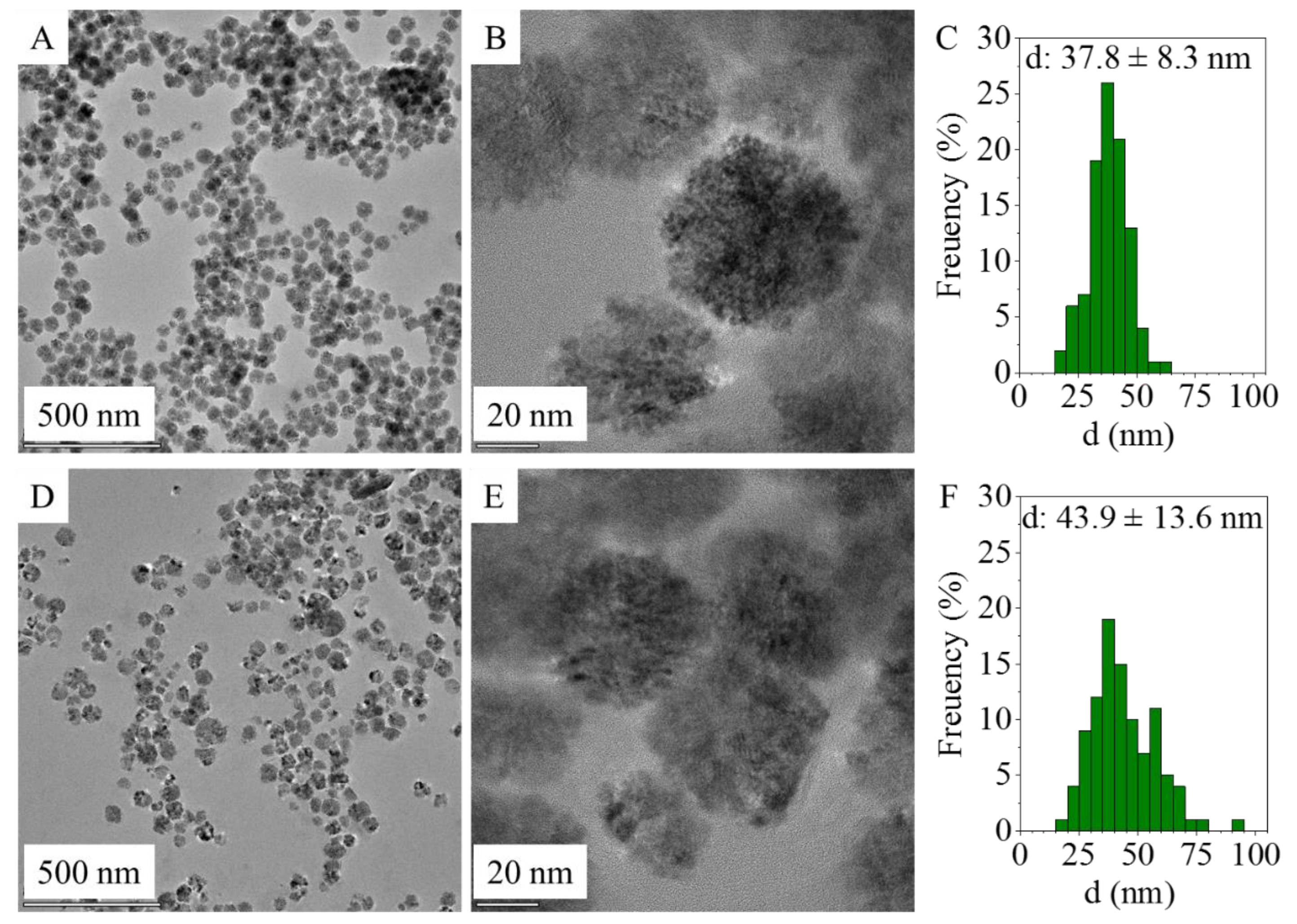
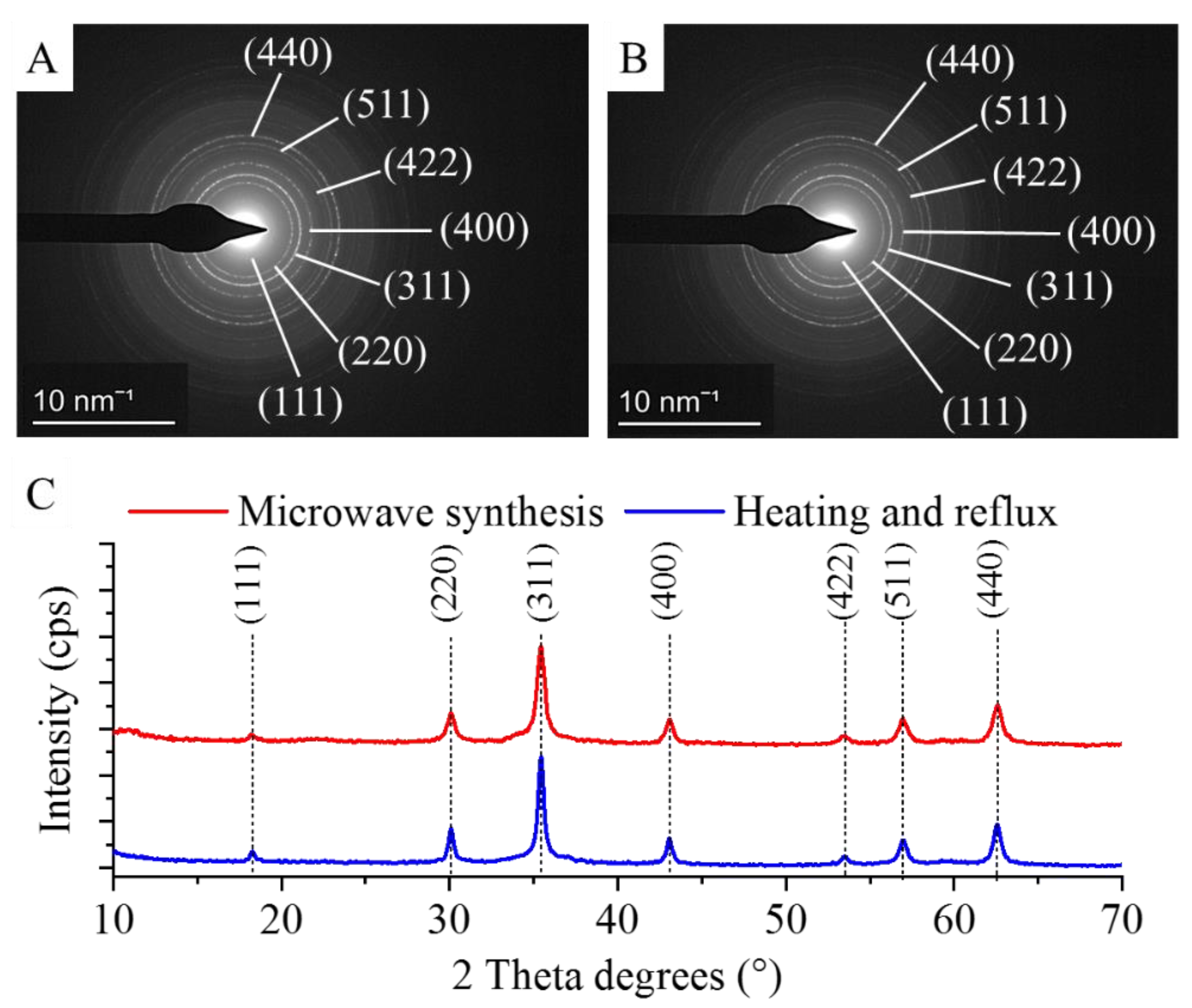
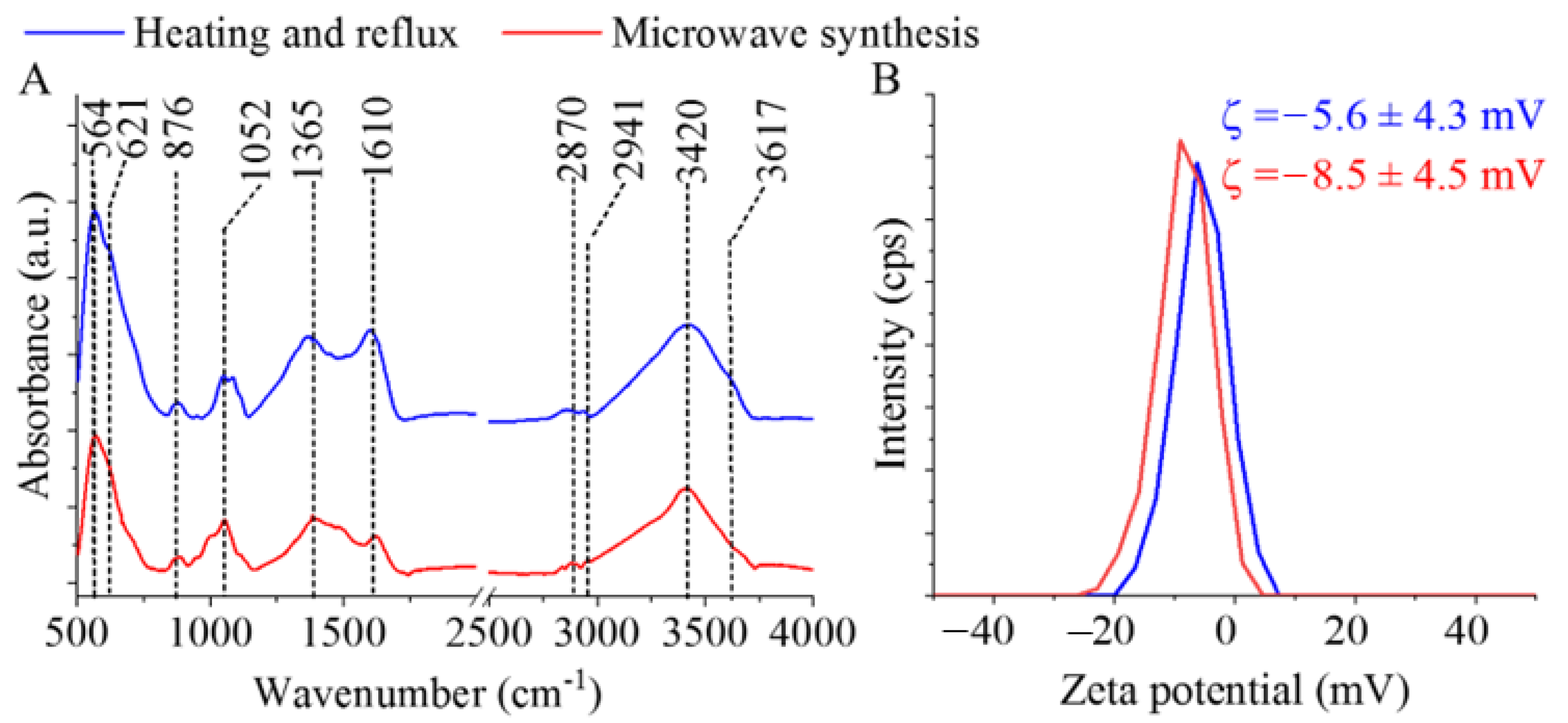
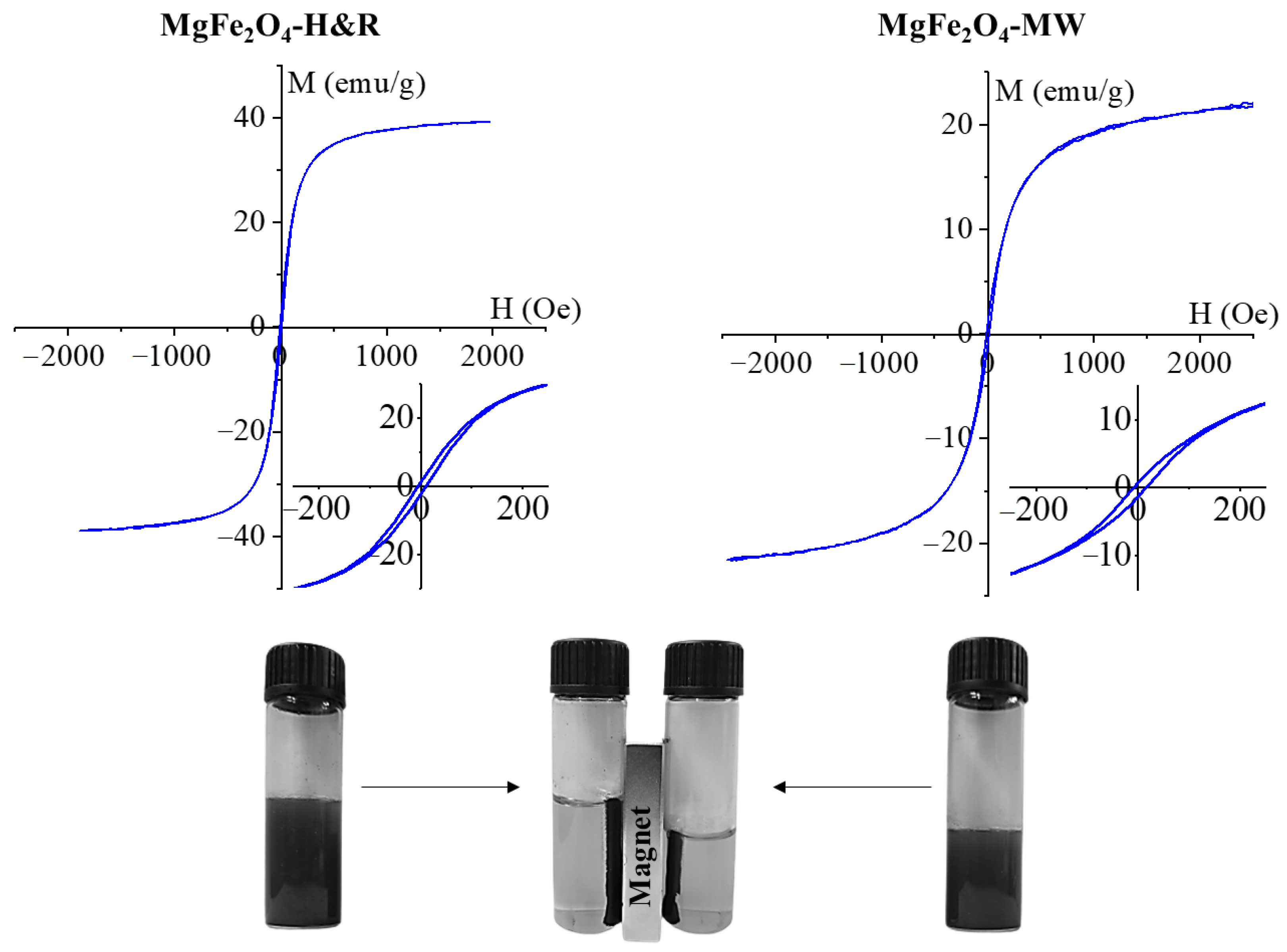
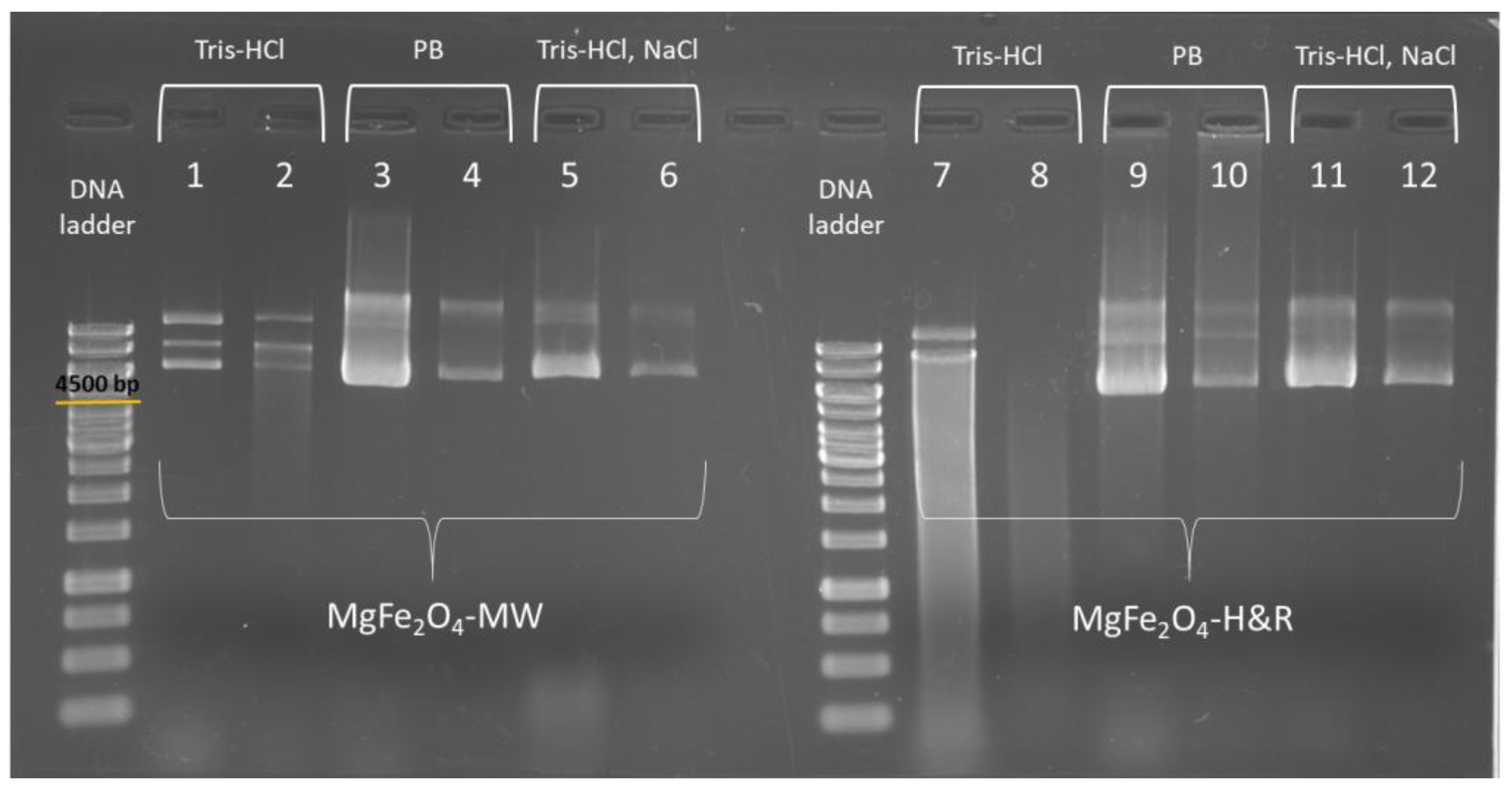
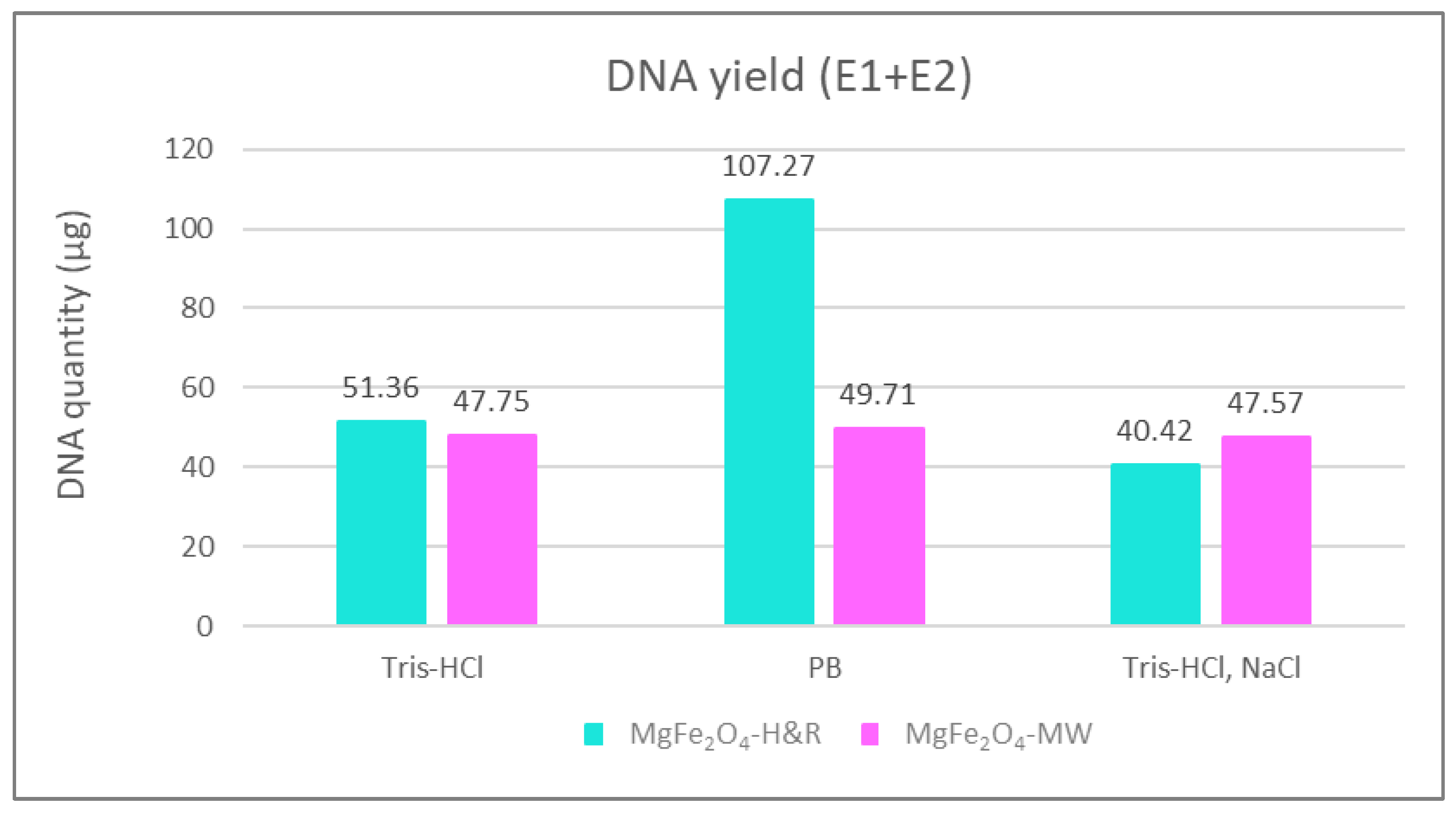

| Synthesis Method | Mean | SD | Min. | Max. | 1st Quartile | 3rd Quartile | Median | P90 | P95 |
|---|---|---|---|---|---|---|---|---|---|
| (nm) | |||||||||
| MW | 43.9 | 13.6 | 17.4 | 91.3 | 33.4 | 53.6 | 41.2 | 61.9 | 68.0 |
| H&R | 37.8 | 8.3 | 18.5 | 62.7 | 32.6 | 43.6 | 37.8 | 47.3 | 50.9 |
Disclaimer/Publisher’s Note: The statements, opinions and data contained in all publications are solely those of the individual author(s) and contributor(s) and not of MDPI and/or the editor(s). MDPI and/or the editor(s) disclaim responsibility for any injury to people or property resulting from any ideas, methods, instructions or products referred to in the content. |
© 2023 by the authors. Licensee MDPI, Basel, Switzerland. This article is an open access article distributed under the terms and conditions of the Creative Commons Attribution (CC BY) license (https://creativecommons.org/licenses/by/4.0/).
Share and Cite
Ilosvai, Á.M.; Gerzsenyi, T.B.; Sikora, E.; Harasztosi, L.; Kristály, F.; Viskolcz, B.; Váradi, C.; Szőri-Dorogházi, E.; Vanyorek, L. Simplified Synthesis of the Amine-Functionalized Magnesium Ferrite Magnetic Nanoparticles and Their Application in DNA Purification Method. Int. J. Mol. Sci. 2023, 24, 14190. https://doi.org/10.3390/ijms241814190
Ilosvai ÁM, Gerzsenyi TB, Sikora E, Harasztosi L, Kristály F, Viskolcz B, Váradi C, Szőri-Dorogházi E, Vanyorek L. Simplified Synthesis of the Amine-Functionalized Magnesium Ferrite Magnetic Nanoparticles and Their Application in DNA Purification Method. International Journal of Molecular Sciences. 2023; 24(18):14190. https://doi.org/10.3390/ijms241814190
Chicago/Turabian StyleIlosvai, Ágnes M., Tímea B. Gerzsenyi, Emőke Sikora, Lajos Harasztosi, Ferenc Kristály, Béla Viskolcz, Csaba Váradi, Emma Szőri-Dorogházi, and László Vanyorek. 2023. "Simplified Synthesis of the Amine-Functionalized Magnesium Ferrite Magnetic Nanoparticles and Their Application in DNA Purification Method" International Journal of Molecular Sciences 24, no. 18: 14190. https://doi.org/10.3390/ijms241814190
APA StyleIlosvai, Á. M., Gerzsenyi, T. B., Sikora, E., Harasztosi, L., Kristály, F., Viskolcz, B., Váradi, C., Szőri-Dorogházi, E., & Vanyorek, L. (2023). Simplified Synthesis of the Amine-Functionalized Magnesium Ferrite Magnetic Nanoparticles and Their Application in DNA Purification Method. International Journal of Molecular Sciences, 24(18), 14190. https://doi.org/10.3390/ijms241814190









